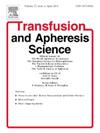revos自动血液处理系统的LR EXT组的中试评估。
IF 1.4
4区 医学
Q4 HEMATOLOGY
引用次数: 0
摘要
revos全自动血液处理系统是迄今为止开发的唯一可以完全自动化地将全血分离成组分的系统。他们专有的LR和NLR采血装置各有优缺点。使用LR装置,可以制备白化成分,但不能制备单个血小板单位。使用NLR装置,可以制备单个血小板单位,但成分是非白细胞耗尽的。新推出的LR EXT具有LR和NLR集的明显优势,已在本试点研究中进行了评估。方法:本研究将从31套LR EXT中制备的血液成分与国家法规以及从LR和NLR中常规制备的成分进行比较。结果:排除未充分收集和血清反应单位,对27套LR EXT制备的成分进行了质量评估。制备的PRBC单位的QC平均体积为296.86 ml, Hct为59.2 %,WBC计数低至0.06 × 106 /袋。FFP单位的平均体积为221.89 ml,平均纤维蛋白原为432.47 mg, FVIII水平为98.13 IU /袋。PLT单位平均体积为73.07 ml, PLT计数为5.74 × 1010,WBC计数为3.21 × 108 /袋。结论:使用LR EXT采血装置有助于实现ld -红细胞和rdp的充分清查,特别是在每日采血率较低的血液中心。本文章由计算机程序翻译,如有差异,请以英文原文为准。
Pilot evaluation of LR EXT sets of the Reveos automated blood processing system
Introduction
The Reveos automated blood processing system is the only system developed till date, which can separate whole blood into components on complete automation. Their proprietary LR and NLR blood collection sets have their own advantages and disadvantages. Using LR sets, leukodepleted components can be prepared but individual platelet units cannot be prepared. Using NLR sets, individual platelet units can be prepared, but components are non-leukodepleted. The newly launched LR EXT with the apparent advantage of both LR and NLR sets have been evaluated in this pilot study.
Methodology
Blood components prepared from 31 LR EXT sets were evaluated in this study in comparison with the National regulations and with components routinely prepared from LR and NLR sets.
Results
Excluding under-collected and sero-reactive units, components prepared from 27 LR EXT sets were evaluated for their quality. QC of PRBC units prepared had a mean volume of 296.86 ml, Hct of 59.2 % and WBC count as low as 0.06 × 106 per bag. FFP units had a mean volume of 221.89 ml, mean Fibrinogen of 432.47 mg and FVIII levels of 98.13 IU per bag. PLT units had a mean volume of 73.07 ml, PLT count of 5.74 × 1010 and WBC count of 3.21 × 108 per bag.
Conclusion
The use LR EXT blood collection sets help in achieving adequate inventory of both LD-PRBCs and RDPs especially in blood centres with a lower daily collection rate.
求助全文
通过发布文献求助,成功后即可免费获取论文全文。
去求助
来源期刊
CiteScore
3.60
自引率
5.30%
发文量
181
审稿时长
42 days
期刊介绍:
Transfusion and Apheresis Science brings comprehensive and up-to-date information to physicians and health care professionals involved in the rapidly changing fields of transfusion medicine, hemostasis and apheresis. The journal presents original articles relating to scientific and clinical studies in the areas of immunohematology, transfusion practice, bleeding and thrombotic disorders and both therapeutic and donor apheresis including hematopoietic stem cells. Topics covered include the collection and processing of blood, compatibility testing and guidelines for the use of blood products, as well as screening for and transmission of blood-borne diseases. All areas of apheresis - therapeutic and collection - are also addressed. We would like to specifically encourage allied health professionals in this area to submit manuscripts that relate to improved patient and donor care, technical aspects and educational issues.
Transfusion and Apheresis Science features a "Theme" section which includes, in each issue, a group of papers designed to review a specific topic of current importance in transfusion and hemostasis for the discussion of topical issues specific to apheresis and focuses on the operators'' viewpoint. Another section is "What''s Happening" which provides informal reporting of activities in the field. In addition, brief case reports and Letters to the Editor, as well as reviews of meetings and events of general interest, and a listing of recent patents make the journal a complete source of information for practitioners of transfusion, hemostasis and apheresis science. Immediate dissemination of important information is ensured by the commitment of Transfusion and Apheresis Science to rapid publication of both symposia and submitted papers.

 求助内容:
求助内容: 应助结果提醒方式:
应助结果提醒方式:


